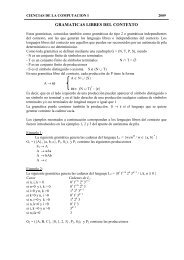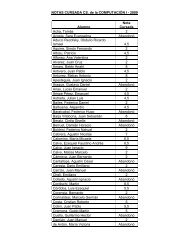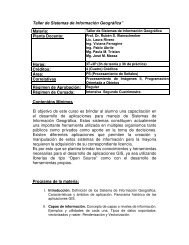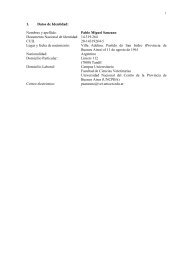Libro de Resúmenes / Book of Abstracts (Español/English)
Libro de Resúmenes / Book of Abstracts (Español/English)
Libro de Resúmenes / Book of Abstracts (Español/English)
You also want an ePaper? Increase the reach of your titles
YUMPU automatically turns print PDFs into web optimized ePapers that Google loves.
Resumenes 93<br />
punto <strong>de</strong> equilibrio y oscilaciones <strong>de</strong> población amortiguadas, analizando un<br />
mo<strong>de</strong>lo <strong>de</strong> <strong>de</strong>predación tiempo continuo <strong>de</strong>scrito por el sistema:<br />
⎧ dx x<br />
⎪ = r(<br />
1−<br />
) x − q ( x − xr<br />
) y<br />
dt K<br />
X µ : ⎨<br />
⎪ dy<br />
= ( p ( x − x − c)<br />
y<br />
⎪<br />
r )<br />
⎩ dt<br />
y consi<strong>de</strong>rando las siguientes hipótesis acerca <strong>de</strong>l refugio <strong>de</strong> las presas: el<br />
número <strong>de</strong> presas protegidas xr es ya sea una fracción constante <strong>de</strong>l total,<br />
un número fijo [9], o proporcional a la abundancia <strong>de</strong> <strong>de</strong>predadores [11].<br />
Nuestros resultados indican que el refugio pue<strong>de</strong> preservar la estabilidad <strong>de</strong>l<br />
punto <strong>de</strong> equilibrio positivo <strong>de</strong>l sistema.<br />
Dynamics <strong>of</strong> simple predator-prey mo<strong>de</strong>ls with prey refuge<br />
use. A small review and new findings<br />
Within the field <strong>of</strong> population dynamics, the so-called predator<br />
functional response to prey <strong>de</strong>nsity refers to the <strong>de</strong>nsity <strong>of</strong> prey attacked<br />
per unit time per predator as a function <strong>of</strong> prey <strong>de</strong>nsity [5]. In most<br />
predator-prey mo<strong>de</strong>ls consi<strong>de</strong>red in the literature, the functional response is<br />
assumed to be monotonically increasing, the inherent assumption being<br />
that the more prey in the environment, the better <strong>of</strong>f the predator.<br />
To incorporate biological realism into the basic formal framework<br />
<strong>de</strong>veloped in the first half <strong>of</strong> the XX century by Volterra and others, <strong>de</strong>nsity<strong>de</strong>pen<strong>de</strong>nt<br />
effects on the endogenous dynamic <strong>of</strong> predators and prey, and<br />
non-linear functions for consumption <strong>of</strong> prey by predators were inclu<strong>de</strong>d [3,<br />
7]. More recently, the behavior <strong>of</strong> prey and its consequences at the<br />
population level has been incorporated into the predation theory [13]. In<br />
this context, one <strong>of</strong> the more relevant behavioral traits affecting the<br />
dynamics <strong>of</strong> predator-prey systems is the use <strong>of</strong> spatial refuges by the prey.<br />
Here we consi<strong>de</strong>r a refuge as a physical location in which prey either live or<br />
temporarily hi<strong>de</strong> [9], where predators have little or no chance to kill prey.<br />
According to Taylor [15] the different kinds <strong>of</strong> refuges can be<br />
arranged into three types:<br />
a) those which provi<strong>de</strong>s permanent spatial protection for a small<br />
subset <strong>of</strong> the prey population,<br />
b) those which provi<strong>de</strong> temporary spatial protection, and<br />
c) those which provi<strong>de</strong> a temporal refuge in numbers, i.e. <strong>de</strong>crease<br />
the risk <strong>of</strong> predation by increasing the abundance <strong>of</strong> vulnerable prey.<br />
From a theoretical point <strong>of</strong> view, different forms <strong>of</strong> mathematical<br />
representations <strong>of</strong> refuge use in a population context have been presented.<br />
These mo<strong>de</strong>ls, mostly invoking either environment heterogeneity or some<br />
type <strong>of</strong> phenotypic structure in the prey, relies on different basic<br />
assumptions and therefore their results are hardly comparable.<br />
Different forms <strong>of</strong> mathematical representations <strong>of</strong> refuge have been<br />
used in a population context; some invoke environment heterogeneity while<br />
others some type <strong>of</strong> phenotypic structure in the prey. However, because<br />
they rely on different basic assumptions their results are hardly comparable.<br />
By analyzing a continuous time predator-prey mo<strong>de</strong>l <strong>de</strong>scribed by the<br />
system:



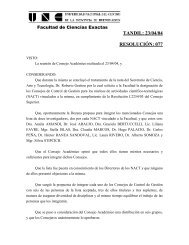
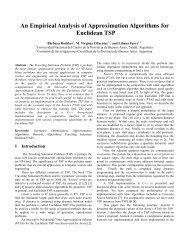
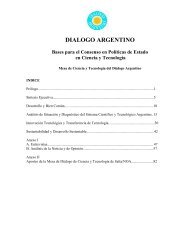
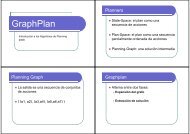
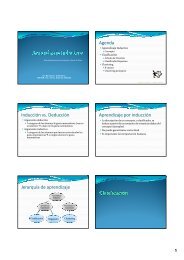
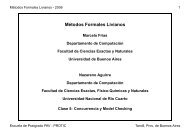
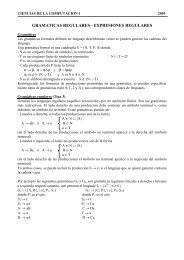

![Clase 13 [pdf]](https://img.yumpu.com/19616969/1/190x245/clase-13-pdf.jpg?quality=85)

